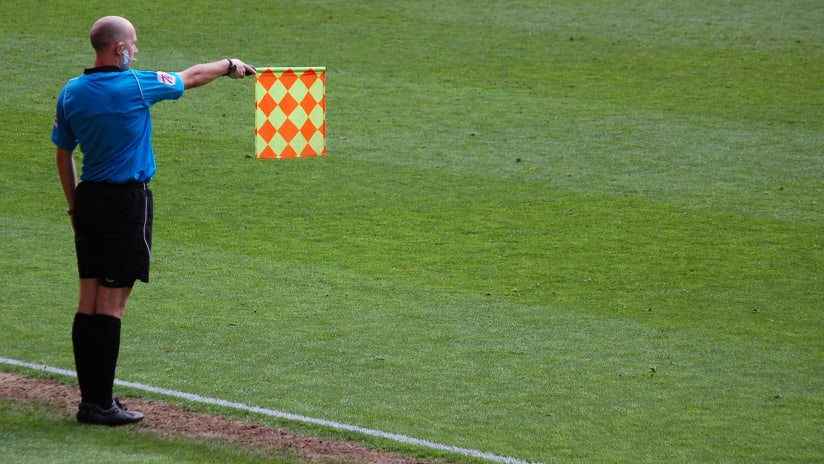If you were watching last week’s U.S. Open Cup match against FC Cincinnati, you saw several compelling attacking plays blown dead because Emery Welshman — Cincinnati’s absolute unit of a forward — was offside. If you were following MNUFC last year, you saw the same thing happen to rookie forward Abu Danladi several times. Many young strikers struggle with timing their runs correctly, especially against higher levels of defense. It’s something that Minnesota United’s coaches have been working with Danladi on — that ability to bait a defender back a bit before floating onside and then rocketing forward the moment the ball is played in.
But you might find yourself asking, “Why is this technique even necessary?” Any soccer fan has known the pain of seeing what looked like a spectacular breakaway goal being called back. If you’ve been at this a while, you likely accept it, but you’ve probably also been sitting with someone a little newer to the game whose reaction to an offside call has been: “That’s a dumb rule.”
But here’s the thing about offside: it’s not. It’s easy to get so caught up in the action of a game that rules begin to only seem like they keep you from doing things, rather than being what enables the game to exist in the first place. And the offside rule in soccer is that kind of architectural rule: it gives the game its shape, makes soccer as we know it possible.
Let’s go over the rule. First of all, it is not in itself against the rules to be in an offside position. Players are in offside positions all the time. It just means that any part of a player’s head, body or feet (it’s important to note that arms are not included) is nearer to the opponents’ goal line than both the ball and the second-to-last opponent. (That last part keeps the goalkeeper out of the equation, generally, plus you can’t be offside in your own half.) Being in that position becomes an offense that stops the play if a player is in that position when the ball is played to him or if he is in some way engaged in the play in such a way that it affects the outcome.
The fact that it’s not inherently illegal to be offside is, I suspect, what makes the rule a little confusing — plus the fact that it doesn’t refer to an absolute position on the pitch. Aside from the aforementioned provision about the halfway line, the space that constitutes offside is constantly shifting. It’s subject to the judgment of the assistant referee along the sideline and, occasionally, to the people in the video review booth.
The rule defines an ever-changing marker (the second-to-last defender) and then makes judging if an offensive player’s progress past that marker is illegal dependent on other events on the field, and often quite distant ones. A lobbed through ball from across the pitch can trigger an offside call, and this is often the kind of play that leads to casual observers getting confused. They’re probably watching the ball.
But like most any sport, it’s what’s happening off the ball that’s the most interesting: the way players are maneuvering in space, how they’re overloading one side of the field, how they’re running just even with that second-to-last defender. That’s where the game is really happening, and that’s why offside is so important in what it makes possible. Without it, strikers could just set up shop in the penalty box and wait for long balls. And if they did that, then defenders would have to stay back there with them. The middle of the field would be a barren wasteland, with marooned midfielders waving and yelling to their distant teammates.
But with the offside rule, savvy defenders can push up and force their opponents offside. It can be a defensive tactic. And offensive players can bait them, make them drop back or else make them think about dropping back before cutting at just the right moment into open space. It’s a limitation that opens up possibilities.
Consider it like atonality in improvising music — “wrong” notes, in short. If a jazz musician just flat out plays in the wrong key, it’s going to sound awful. Ref blows the whistle, offside. But if he or she just brushes up against those clunky notes, pokes and prods you with them to question where the song is going, it gives the music dynamism, tension, release. No whistle, play on.
Midfielder Ethan Finlay talked about it earlier in the season when discussing his goal against Orlando City.
“You just have to kind of feel and know where the line is,” he said. “And I’ve done a pretty good job of it over the last seven years — to just be on the back shoulder of guys, to run the line. And it’s somewhat instinct, it’s somewhat luck, don’t get me wrong. But you have to continue to do it over 90 minutes. And there’s plenty other runs that I’ll be a tad late. The timing all has to come together.”
Working the offside line is less a set of steps that lead to a result and more a calculated risk taken repeatedly in the hopes that it pays off spectacularly once. The offside call exists at the fringes of what’s legal, where intuition, creativity and vision combine to give a team just enough of an edge to make something happen, which is just how it should be.





